Neuro Peripheral Nerves: Functions and Clinical Insights
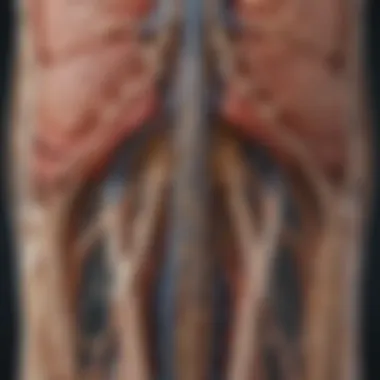
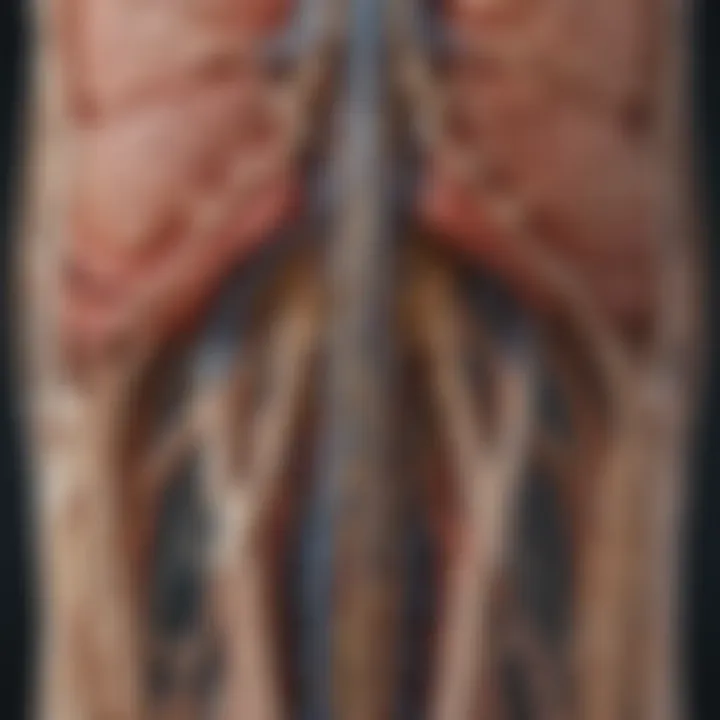
Intro
Understanding the complex network of neuro peripheral nerves is crucial for comprehending how the human body interacts with its environment. These nerves serve as communication highways, relaying signals between the brain, spinal cord, and various parts of the body. When they function properly, we experience a seamless connection between thought and action, sensation and response. However, when these nerves are damaged or dysfunctional, the implications can be significant, affecting mobility, sensation, and overall wellbeing.
This examination focuses on the critical roles that neuro peripheral nerves play in our daily lives, including how they impact sensory and motor functions. Furthermore, we will explore the common disorders that can arise, the diagnostic methods employed to assess nerve health, and the latest treatment options available. As we delve deeper into this topic, we aim to equip researchers, healthcare professionals, and students with a solid foundation of knowledge regarding peripheral nerve biology and its clinical implications.
Research Context
Background and Rationale
Peripheral nerves are not just mere cords within our bodies; they are pivotal to processing sensory information and executing voluntary movements. The rationale for examining these nerves lies in their profound impact on daily functioning. Take, for example, the way we experience pain or touch. These sensations rely entirely on the intact functioning of peripheral nerves. Conditions arising from nerve damage—such as diabetic neuropathy or carpal tunnel syndrome—can drastically alter an individual’s quality of life.
Furthermore, understanding the anatomy and physiology of these nerves is fundamental for healthcare professionals to devise targeted therapeutic interventions. Knowledge of how these nerves operate can lead to advancements in treatments, improving patient outcomes significantly.
Literature Review
The existing body of literature on peripheral nerves highlights various aspects of their functions and disorders. Various studies stress the importance of neuroplasticity—the ability of peripheral nerves to adapt and regenerate following injury. For instance, articles from PubMed demonstrate a clear correlation between timely rehabilitation exercises and positive patient recovery outcomes.
Moreover, a detailed review of recent advancements in nerve imaging techniques—especially those utilizing MRI—offers insights into safer and more effective diagnostic practices. Resources such as Britannica and clinical journals have detailed the various nerve disorders, allowing for a better understanding of pathophysiology and treatment protocols. This accumulation of knowledge forms the backbone of our endeavor to refine clinical practices.
In summary, the exploration of neuro peripheral nerves encompasses a broad spectrum of medical science, offering a rich terrain for research and clinical application. This section sets the stage for subsequent discussions regarding the methodologies and detailed investigations into this vital area of study.
Prolusion to Neuro Peripheral Nerves
Understanding neuro peripheral nerves is akin to grasping the wiring of a complex machine. These nerves are the unsung heroes that bridge the gap between our brain and body, orchestrating how we interact with our world. They are not just extensions of the nervous system; they are critical players in ensuring that signals travel seamlessly, allowing sensations to be felt, movements to be coordinated, and responses to stimuli to be executed efficiently. With this foundational knowledge, let's take a closer look at how these nerves fit into the grander scheme of human physiology.
Defining Neuro Peripheral Nerves
Neuro peripheral nerves can be defined simply as the network of nerves outside the brain and spinal cord, which are part of the peripheral nervous system. This system encompasses millions of fibers that carry signals to and from various parts of the body. These signals can either be sensory, like feeling pain or touch, or motor, which control muscle movements. Quite a bit of activity happens along these pathways, and understanding their definition helps us appreciate why they are so crucial.
It's interesting to note that these nerves come in various types, each serving unique functions. For instance, sensory nerves relay information from sensory receptors to the central nervous system. Motor nerves do the opposite by transmitting commands from the central nervous system to muscles, enabling motion. Mixed nerves, as the name suggests, incorporate both sensory and motor fibers, acting as dual-function cables in the nerve network. Their classification emphasizes the complex interplay between different nerve types, vital for bodily functions.
The Role of Peripheral Nerves in the Nervous System
Peripheral nerves hold an absolutely pivotal role in the overall functionality of the nervous system. First and foremost, they serve as the communication lines that connect the brain and the spinal cord to limbs and organs. Without these nerves, the central nervous system would be unable to relay critical information needed for homeostasis.
Here's where it gets fascinating: the precise organization of these nerves allows for rapid communication. Consider how swiftly your hand pulls away from a hot stovetop—this is thanks to the ultra-fast signaling made possible by these nerves. When you touch something hot, sensory receptors relay that information through the peripheral nerves to your spinal cord and brain at lightning speed.
Moreover, peripheral nerves are involved in reflex arcs that enable quick, involuntary movements in response to stimuli. For example, if you accidentally touch something prickly, your body’s immediate reaction is to withdraw. This reflex action, made possible by peripheral nerves, is a beautiful example of how the body protects itself without the need for conscious thought.
"Peripheral nerves not only transmit signals but also contribute to the intricate dance of motor control, sensory perception, and the maintenance of bodily functions."
In summary, grasping the importance of neuro peripheral nerves sheds light on their multifaceted role in the human nervous system. As we delve deeper into their anatomy and physiology, we’ll uncover even more about how these vital structures impact our health and wellbeing. In the next sections, we will take a closer look at the anatomy of these nerves, their physiological functions, and common disorders that may disrupt their incredible work.
Anatomy of Peripheral Nerves
Understanding the anatomy of peripheral nerves is invaluable for both clinical practices and academic research. Delving into their structure illuminates the complexity behind how these nerves function within the human body. The intricate layout of peripheral nerves impacts not only their ability to transmit signals efficiently but also plays a crucial role in diagnosing disorders. By grasping the structural elements, practitioners can better interpret symptoms and develop targeted treatments, enhancing patient care.
Structure of Peripheral Nerves
Peripheral nerves are composed of bundles of nerve fibers, all wrapped together in protective tissue. The outermost layer is called the epineurium, which provides a protective sheath around the entire nerve. Beneath this is the perineurium, encasing bundles of fibers known as fascicles. Each fascicle is further composed of individual nerve fibers surrounded by the endoneurium, a delicate membrane. This layered structure is fundamental to the health and functionality of nerves. It allows for the support and protection of nerve fibers while facilitating their rapid signal transmission.
Moreover, understanding this structure offers insight into how injuries or diseases can affect nerve function and recovery. Damage to any layer can disrupt the whole system, leading to various neurological disorders. Thus, familiarity with these components serves as a cornerstone for anyone studying or treating nerve-related conditions.
Nerve Fascicles and Their Organization
Nerve fascicles, often likened to strands of spaghetti in a bowl, group individual nerve fibers that perform similar functions. Each fascicle contains a mix of sensory and motor fibers, showcasing the versatility inherent in peripheral nerves. The organization into fascicles allows for a more efficient arrangement of nerve fibers, reducing the risk of damage and aiding in regeneration after injury.
The orientation and arrangement also reflect how well the nerve can transmit impulses. For instance, when a nerve is compressed or injured, the fascicle organization can determine how the nerve recovers. More organized fascicles may allow for a more effective healing process, while disorganized fibers may result in dysfunction. Recognizing this can inform treatment plans, emphasizing the importance of proper nerve structure in rehabilitation approaches.
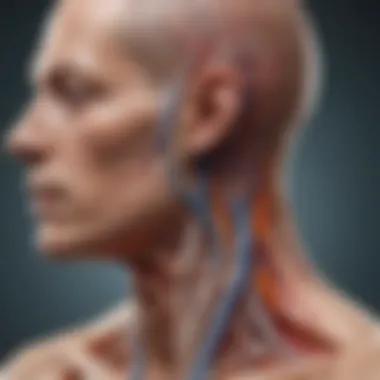
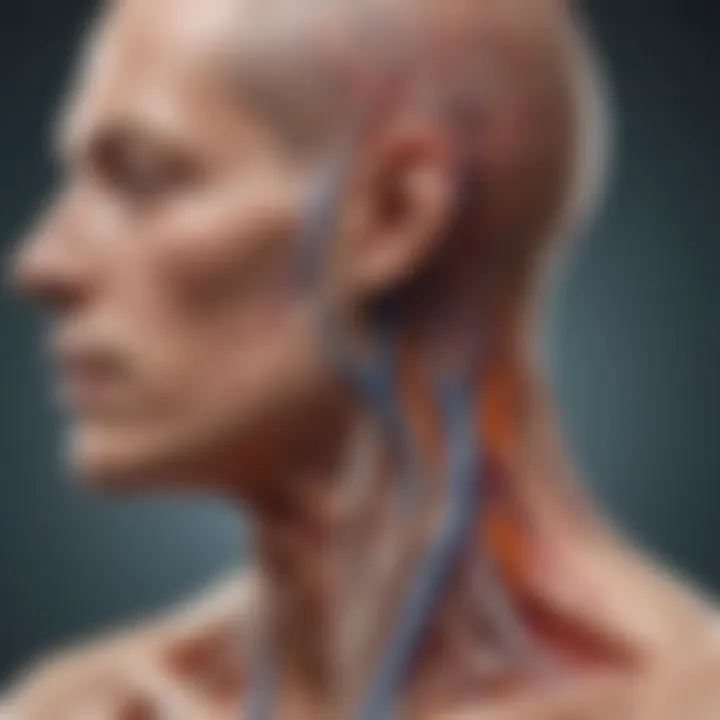
Types of Peripheral Nerves
Peripheral nerves can be classified into three main categories:
- Mixed Nerves
These nerves contain both sensory and motor fibers, making them a key player in peripheral nerve functionality. Mixed nerves are critical in transmitting signals to and from the central nervous system, ensuring proper communication within the body. Their dual functionality allows for a seamless exchange of information. For instance, the median nerve, a mixed nerve, is essential for both sensation in the hand and muscle movement. - Motor Nerves
Motor nerves solely contain fibers that transmit signals from the central nervous system to muscles, facilitating movement. They play a fundamental role in voluntary movements, like picking up a cup or running. A specific characteristic of motor nerves is their direct connection to muscle fibers, known as the neuromuscular junction. This direct tie ensures swift responses to voluntary actions, though it also makes them vulnerable to injuries that can lead to muscle atrophy if not promptly addressed. - Sensory Nerves
In contrast, sensory nerves are dedicated to relaying information from sensory receptors back to the central nervous system. These nerves allow us to perceive sensations such as touch, temperature, and pain. Their primary characteristic is the ability to convert physical stimuli into electrical signals the brain can interpret. A classic example is the sciatic nerve, which helps transmit pain sensations from the legs. However, while sensory nerves are essential for our survival, they can also be prone to neuropathic pain if damaged, which complicates clinical outcomes.
Each type of nerve plays a distinct role in maintaining the body's function, and understanding their individual characteristics is paramount for anyone involved in health care or research.
Physiology of Neuro Peripheral Nerves
Understanding the physiology of neuro peripheral nerves is fundamental as it highlights how these structures facilitate communication within the nervous system. The pathways for transmitting signals between the brain and the rest of the body hinge on intricate processes that occur within these nerves. Grasping these processes not only elucidates their functions but also sheds light on the implications when malfunctions occur.
Transmission of Nerve Impulses
Nerve impulse transmission is a finely tuned process that hinges on the propagation of electrical signals known as action potentials. The initiation of an action potential occurs when a neuron is sufficiently stimulated beyond a threshold level. This action produces a rapid change in membrane potential, where sodium ions rush into the neuron, leading to depolarization. Another critical player in this transmission process is the ion channels, which open and close in response to changes in voltage.
- Stages of Action Potentials:
- Resting potential: The neuron is at rest.
- Depolarization: Sodium influx shifts the internal charge.
- Repolarization: Potassium exits to restore balance.
- Hyperpolarization: The neuron temporarily becomes more negative than the resting state.
These impulses travel along the nerve fibers, achieving incredibly high speeds, particularly in myelinated fibers. In simple terms, myelination permits faster signal transmission, allowing a coordinated response system that is essential for reflexes and voluntary movements.
Neurotransmitters and Their Functions
Neurotransmitters play an essential role in the communication between neurons and target cells. These are chemical messengers that cross synaptic gaps to transmit signals. Different neurotransmitters serve diverse purposes, influencing everything from muscle contraction to mood regulation. Here are a few notable neurotransmitters:
- Acetylcholine: Often involved in muscle activation and attention.
- Serotonin: Impacts mood, sleep, and appetite.
- Dopamine: Crucial for reward mechanisms and motor control.
The intricate balance of these chemicals is vital. For instance, an imbalance in serotonin levels can lead to conditions such as depression. Therefore, a deep understanding of neurotransmission can aid in identifying potential therapies for various neurological and psychological disorders.
Myelination and Nerve Conduction Velocity
Myelination enhances conduction velocity of nerve impulses. Myelin sheath, comprised of lipid-rich layers, envelops the axons of many peripheral nerves, allowing for faster signal transmission. The nodes of Ranvier, which are small gaps in the myelin sheath, permit the action potential to jump from one node to the next—this process is called saltatory conduction.
For example, in healthy myelinated nerve fibers, impulse conduction can reach up to 120 meters per second. In contrast, unmyelinated fibers transmit signals at a much slower rate, around 0.5 to 2 meters per second.
"Accelerated nerve conduction in myelinated fibers is essential for quick reflex actions and timely responses to stimuli, showcasing how structure directly influences function."
Common Peripheral Nerve Disorders
The examination of common peripheral nerve disorders is a crucial facet of understanding neuro peripheral nerves. These disorders can significantly impact a person’s quality of life and functional abilities. Recognizing the clinical implications associated with these conditions can aid in early detection and effective management. It’s essential for students, researchers, and healthcare professionals alike to grasp the intricacies of these ailments not just on a theoretical level, but through tangible examples and clinical experiences.
Peripheral Neuropathy
Peripheral neuropathy refers to a broad category of conditions that impact peripheral nerves, often resulting in weakness, numbness, and pain—predominantly in the hands and feet. This disorder arises from various causes, including diabetes, trauma, infections, and even exposure to toxins.
- Symptoms: The clinical manifestations can range widely. Patients might experience:
- Importance of Awareness: Understanding peripheral neuropathy is vital due to its growing prevalence, particularly among populations with chronic conditions such as diabetes. This knowledge drives research and guides clinical practices aimed at addressing neuropathic pain and improving patient mobility
- Tingling sensations (often described as ‘pins and needles’)
- Burning or shooting pains
- Reduced ability to feel pain or temperature changes
- Muscle weakness and coordination difficulties
Carpal Tunnel Syndrome
Carpal tunnel syndrome (CTS) is a specific type of peripheral neuropathy that stems from compression of the median nerve in the wrist. The prevalent nature of this disorder among carpal tunnel syndrome patients underscores its significance in clinical conversations about peripheral nerve conditions.
- Causes: Carpal tunnel syndrome can be attributed to repetitive wrist movements—common in various occupations like typing, assembly line work, or even certain crafts.
- Symptoms: Individuals often report:
- Numbness or tingling in the thumb and the first three fingers
- Weakness in grip strength
- Symptoms tend to flare up at night or during specific activities
"Early detection of carpal tunnel syndrome can substantially improve outcomes; too often, treatment is delayed until it becomes debilitating."
Effective management can range from splinting and avoiding aggravating activities to surgical interventions in cases where conservative treatments are not effective. Understanding this condition can lead to more effective prevention strategies, especially for high-risk groups.
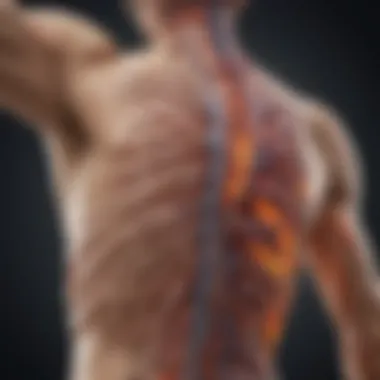
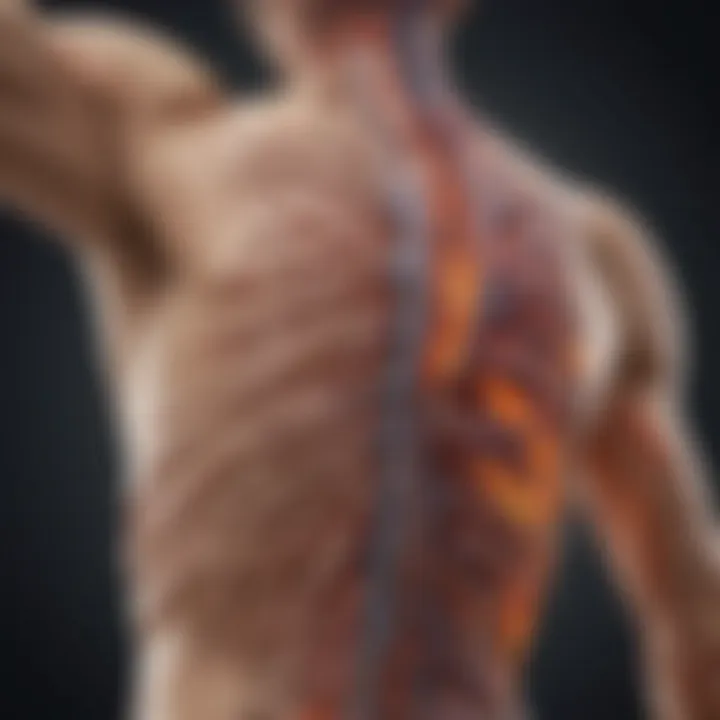
Sciatica and its Implications
Sciatica is rooted in issues along the sciatic nerve, which extends from the lower back through the hips and buttocks and down each leg. Often caused by a herniated disc or spinal stenosis, sciatica emphasizes the importance of lumbar health on the overall function of peripheral nerves.
- Symptoms: Patients might feel:
- Clinical Implications: Recognizing sciatica doesn't merely involve pain management; it requires an understanding of its underlying causes. Failure to address the root causes can lead to chronic pain and reduction in mobility. When left untreated, it can create a cascade of issues affecting the patient's overall quality of life.
- Sharp pain that radiates from the lower back into the leg
- Numbness or weakness in affected legs
- Pain that can worsen with sitting or certain movements
In summary, common peripheral nerve disorders like peripheral neuropathy, carpal tunnel syndrome, and sciatica demonstrate the diverse implications of peripheral nerve health. These conditions illuminate the need for thorough clinical knowledge and patient education to foster proactive management and treatment strategies.
Diagnosis and Assessment of Peripheral Nerve Disorders
Understanding how to diagnose and assess peripheral nerve disorders is like finding a needle in a haystack. The significance of this topic cannot be overstated because accurate diagnosis is essential for effective treatment and management. Neuropathies can manifest with a bewildering array of symptoms, and recognizing the specific nature and severity of these disorders helps guide appropriate interventions. The relevance lies not only in pinpointing the type of nerve damage but also in crafting personalized treatment plans that enhance patient outcomes.
Clinical Evaluation Techniques
Clinical evaluation techniques comprise various approaches that are pivotal in the diagnostic process for peripheral nerve disorders. Physicians often start with a comprehensive patient history and physical examination. Questions about the duration of symptoms, any associated pain, and even lifestyle factors like occupation can shed light on potential causes.
Once the physician understands the patient's background, assessments such as sensory and motor function tests can be performed. For instance, testing reflexes or the ability to feel vibration can help detect abnormalities. Moreover, using simple tools like monofilaments can assess tactile sensitivity. It's a straightforward but effective way of gauging how the nerves are functioning.
Electrophysiological Studies
Electrophysiological studies take diagnosis to another level, measuring the electrical activity of nerves and muscles. This method provides invaluable insight into nerve function, allowing clinicians to assess both the speed and strength of nerve signals. A prominent technique is the nerve conduction study, which involves sending small electrical impulses through nerves. By examining how fast and strong the signals travel, healthcare providers can pinpoint areas of damage or dysfunction.
Electromyography, or EMG, is another method often used in tandem with nerve conduction studies. It assesses how well muscles respond to nerve signals. Abnormalities detected may indicate nerve compression or even more extensive neurological damage. Combined, these studies are like lighting up a dark room, illuminating areas of concern that may otherwise remain hidden.
Imaging Techniques in Nerve Diagnosis
Imaging techniques play a crucial part in charting the course for nerve diagnoses. Two standard imaging modalities — ultrasound and Magnetic Resonance Imaging (MRI) — offer distinct advantages in assessing peripheral nerve pathology.
Ultrasound
Ultrasound is particularly useful because it is non-invasive and allows for real-time visualization of nerves. It can depict nerve structure and identify any compression or entrapment issues, such as those seen in carpal tunnel syndrome. Its ability to visualize surrounding tissues sets ultrasound apart; the nerves can be seen in their anatomical context. One of the standout features of ultrasound is how quickly it provides feedback, which is invaluable in a clinical setting. However, limitations exist; for instance, it may not penetrate deeply into tissues well, thus possibly missing deeper nerves.
Magnetic Resonance Imaging (MRI)
Magnetic Resonance Imaging (MRI) takes the investigation a step further by offering high-resolution images of the body’s internal structure, including soft tissues and nerves. The key characteristic of MRI is its exceptional detail, which allows for the identification of structural anomalies. Conditions like tumors or herniated discs can be easily visualized, assisting in determining the underlying causes of nerve pain or dysfunction. MRI, while beneficial, does require specific conditions for optimal imaging and sometimes comes with longer wait times due to its complexity. Nevertheless, its ability to provide a thorough overview of nerve conditions makes it an indispensable tool in diagnostics.
Effective diagnosis of peripheral nerve disorders not only aims to understand the damage itself but also paves the way for targeted intervention strategies that can profoundly impact patient quality of life.
Treatment Modalities for Peripheral Nerve Disorders
Understanding the treatment modalities for peripheral nerve disorders is crucial because they directly influence recovery and the quality of life for individuals suffering from nerve pain and dysfunction. Addressing these issues effectively requires a blend of different approaches, tailored to the specific condition and its severity. The ultimate goal is not only to relieve symptoms but also to restore function and promote healing.
The management of peripheral nerve disorders can frequently involve a combination of pharmacological, surgical, and rehabilitative strategies. Each approach holds distinct benefits and considerations, and the choice often depends on the underlying disorder, the patient's health profile, and the anticipated outcomes.
Pharmacological Interventions
When it comes to medication, a variety of options exist that can help mitigate pain and improve function. Among these, certain analgesics and anti-inflammatory drugs play pivotal roles. Non-steroidal anti-inflammatory drugs (NSAIDs), such as ibuprofen, can help reduce inflammation and alleviate pain for conditions like carpal tunnel syndrome.
Additionally, antidepressants and anticonvulsants are sometimes prescribed, particularly for neuropathic pain. Medications like gabapentin and pregabalin have shown to be effective. Oftentimes, clinicians consider combining therapies to enhance pain relief.
However, it is critical for healthcare professionals to carefully monitor the patient's response and potential side effects, which can range from mild to severe. Sometimes, patients may need adjustments or even a switch in medication, emphasizing the need for ongoing assessment.
Surgical Options for Nerve Repair
In cases where conservative treatments fall short, surgical intervention may be warranted. Surgical options classically include nerve decompression, nerve repair, and nerve grafting. For instance, in cases of severe carpal tunnel syndrome, surgery might be necessary to relieve nerve pressure.
Nerve repair involves suturing the ends of a damaged nerve back together, which can help restore function when the nerve has been severed or deeply injured. In some scenarios, especially with significant injury, nerve grafts from other parts of the body may be needed to bridge the gap and allow regeneration.


Deciding to proceed with surgery necessitates careful evaluation and discussion between the healthcare provider and the patient. The risks versus benefits must be considered comprehensively, and the potential for recovery can vary widely depending on the individual case.
Physical and Occupational Therapy
Physical and occupational therapy are complementary to medical and surgical treatments. They focus on helping patients regain strength, mobility, and functionality. Tailored rehabilitation programs can be incredibly effective, particularly when integrated early in the treatment process.
Physical therapy often involves exercises aimed at enhancing strength and flexibility. For example, specialized stretches can alleviate tension and improve range of motion in affected areas. Occupational therapy, on the other hand, emphasizes adapting activities of daily living and may include techniques and tools to enable patients to carry out daily tasks despite their limitations.
Regular engagement in therapeutic activities can not only contribute to recovery but also empower patients to take an active role in their rehabilitation. It fosters resilience and may even reduce the likelihood of long-term complications.
As with any treatment, it's important to approach each case individually to determine the most effective strategies tailored to the unique needs of the patient.
The multifaceted approach to managing peripheral nerve disorders illustrates the complexities involved. By weaving together pharmacological, surgical, and rehabilitative strategies, healthcare providers can help patients navigate their journey toward recovery.
Future Directions in Peripheral Nerve Research
The exploration of neuro peripheral nerves is on the brink of new breakthroughs, enhancing our understanding and treatment of nerve-related disorders. This section discusses the advancing landscape of research in this domain, emphasizing three key areas: regenerative medicine approaches, diagnostic technologies, and innovative treatment strategies. Such advancements stand to greatly benefit not just healthcare practitioners but also patients dealing with various nerve disorders.
Regenerative Medicine Approaches
Regenerative medicine is a rapidly evolving field aimed at repairing or replacing damaged tissues and organs. In the context of peripheral nerves, this approach is particularly promising. Researchers are investigating the potential of stem cells and growth factors to facilitate nerve regeneration after injury.
Studies have indicated that using a combination of neurotrophic factors with stem cell therapy may enhance the repair process. For example, mesenchymal stem cells found in bone marrow can differentiate into Schwann-like cells, which are vital for myelin production. This regenerative potential not only aids in recovering lost functionalities but may also restore sensation and motor control. The ultimate goal is to develop therapies that are not just effective but also safe and applicable across a wide range of patients.
Emerging Technologies in Diagnostics
In diagnostics, the rise of advanced technologies is revolutionizing how peripheral nerve disorders are detected and assessed. Techniques such as high-resolution ultrasound and magnetic resonance imaging (MRI) have matured in recent years, providing detailed images of nerve structures. These tools elevate our capability to diagnose conditions like carpal tunnel syndrome and peripheral neuropathy precisely.
Moreover, novel diagnostic approaches are in development, including:
- Biomarkers: Identifying specific proteins in the bloodstream that indicate nerve damage can streamline the diagnostic process.
- Functional Imaging: Techniques are being enhanced to visualize nerve activity during various tasks, offering insights into their real-time functions.
These emerging technologies not only lead to quicker diagnoses but can also help tailor individualized treatment plans for patients.
Innovations in Treatment Strategies
Innovative treatment strategies represent a crucial frontier in managing peripheral nerve disorders. Beyond traditional pharmaceutical approaches, there is a growing focus on personalized medicine. Tailoring treatment based on genetic profiles and specific nerve conditions can significantly improve outcomes.
Additionally, non-invasive techniques, such as electrical stimulation therapies, are garnering attention for their ability to promote nerve healing and functionality without surgical intervention.
Considerations Regarding New Treatments
While innovations hold great promise, careful consideration is necessary:
- Safety Trials: New strategies must undergo thorough testing to ensure patient safety and efficacy.
- Accessibility: Making advanced treatment accessible to all patients is critical, so research must also focus on cost-effectiveness.
- Long-term Outcomes: Monitoring the long-term effects of new therapies will provide valuable information on their success and potential side effects.
The End
The conclusion of this article plays a pivotal role in tying together the various threads explored throughout the examination of neuro peripheral nerves. It encapsulates the importance of understanding the functions and clinical implications of these vital structures within the nervous system. As peripheral nerves are essential for both sensory and motor functions, recognizing their significance is paramount for healthcare practitioners, researchers, and students alike.
The key points summarized in the prior section shed light on the intricate anatomy, physiology, and the potential disorders affecting peripheral nerves. The grasp of such knowledge not only aids in better diagnosis and management of conditions like neuropathy and carpal tunnel syndrome, but it also fosters an appreciation for the ongoing research aimed at enhancing treatment strategies.
Moreover, the ongoing need for research in neuro peripheral nerves presents numerous advantages. Continued exploration in regenerative medicine, innovative diagnostic tools, and new therapeutic approaches promises to improve patient outcomes and quality of life.
As we progress, it's critical that we prioritize developments in this field, ensuring that the healthcare community remains informed and prepared to tackle the challenges posed by peripheral nerve disorders. The gravity of the topic underscores its relevance in medical education, clinical practice, and biomedical research, establishing a solid foundation for future investigations.
Summary of Key Points
- Neuro peripheral nerves are integral to both sensory and motor functions in the body.
- Understanding the structure and function aids in diagnosing and treating various neurological disorders.
- Research advancements contribute to improved treatment modalities and management strategies.
The Ongoing Importance of Neuro Peripheral Nerve Research
Research in the realm of neuro peripheral nerves is not just a footnote; it is a necessity that impacts our understanding and management of several medical conditions. As technology evolves and our knowledge extends, the insights gained can lead to groundbreaking therapies.
Consider the potential of regenerative medicine. With successful neural regeneration, it may one day be possible to reverse damage done by injuries or diseases affecting peripheral nerves. Such advancements would significantly enhance treatment options for numerous individuals who currently face limited remedies.
Furthermore, investing effort into innovative diagnostic methods, such as refined imaging techniques, can vastly improve how we detect nerve-related disorders. Faster and more accurate diagnoses could lead to timely interventions, ultimately fostering better health outcomes.



